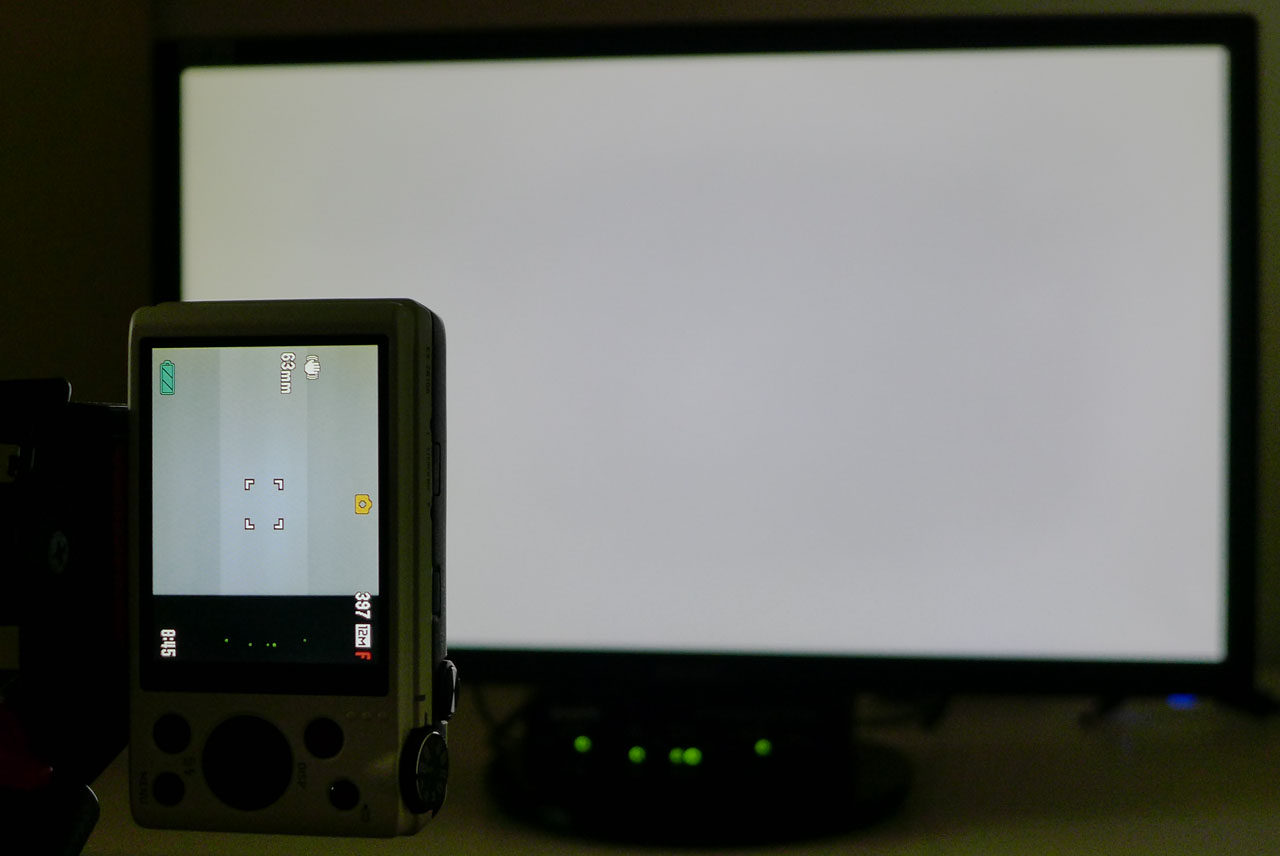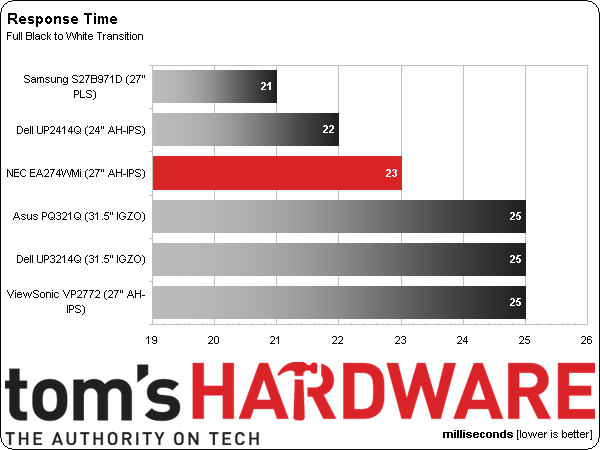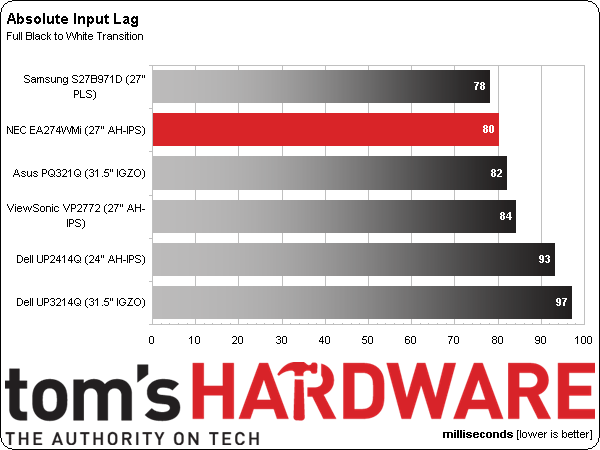NEC EA274WMi Monitor Review: Eco-Friendly At 2560x1440
The high pixel density of a 27-inch QHD monitor is fast becoming the desktop standard for power users. But prices are stalled in the $600 to $800 range. Today we check out NEC’s entry, the EA274WMi. Our hands-on review reveals what you get for your money.
Results: Pixel Response And Input Lag
To perform these tests, we use a high-speed camera that shoots at 1000 frames per second. Analyzing the video frame-by-frame allows us to observe the exact time it takes to go from a zero percent signal to a 100% white field.
The pattern generator is placed at the base of the monitor so our camera can capture the precise moment its front-panel LED lights up, indicating that a video signal is being received by the monitor. With this camera placement, we can easily see how long it takes to fully display a pattern after pressing the button on the generator’s remote. This testing methodology allows for accurate and repeatable results when comparing panels.
Here’s a shot of our test setup. Click on the photo to enlarge.
The brighter section of the camera’s screen is what actually appears in the video. You can see the lights of the pattern generator in the bottom of the viewfinder. We flash the pattern on and off five times and average the results.
Here’s the screen draw result.
This is a predictable result from an IPS panel running at a 60 Hz. Since efforts to improve draw time are currently being directed towards high-refresh and G-Sync-capable TN screens, we don’t expect this level of performance to change any time soon.
Here are the lag results.
Get Tom's Hardware's best news and in-depth reviews, straight to your inbox.
The EA274WMi is a tad quicker than other recently-tested monitors. While none of the group is classified as gaming-oriented, an input lag of 80 milliseconds is sufficient for all but the fastest titles.
Current page: Results: Pixel Response And Input Lag
Prev Page Results: Viewing Angles And Uniformity Next Page NEC EA274WMi: Some Unique Features
Christian Eberle is a Contributing Editor for Tom's Hardware US. He's a veteran reviewer of A/V equipment, specializing in monitors. Christian began his obsession with tech when he built his first PC in 1991, a 286 running DOS 3.0 at a blazing 12MHz. In 2006, he undertook training from the Imaging Science Foundation in video calibration and testing and thus started a passion for precise imaging that persists to this day. He is also a professional musician with a degree from the New England Conservatory as a classical bassoonist which he used to good effect as a performer with the West Point Army Band from 1987 to 2013. He enjoys watching movies and listening to high-end audio in his custom-built home theater and can be seen riding trails near his home on a race-ready ICE VTX recumbent trike. Christian enjoys the endless summer in Florida where he lives with his wife and Chihuahua and plays with orchestras around the state.
-
mikenygmail My 27" Monoprice IPS monitor was $300 total, with $10 in Rakuten credit to boot. So, it could be considered to be $290.Reply
I'm sure this monitor is slight better, but come on NEC, $800 is ridiculous.
Even more ridiculous is this quote from the review:
"At $800, this is the least-expensive high-res model in the line. "
haha! -
SessouXFX I'll be glad when the QHD's get down to a more affordable price. They've been out for quite some time now. There's no reason to keep building these monitors for such a high premium, when 4K is on the horizion. Also, they should build these QHD's with better refresh rates already, and bigger screens too. We should be able to go to the store and buy quality 30 in.+ QHD's at around $300-600.Reply -
airborne11b FFS! The ROG Swift is going to be coming out soon and it's sporting 144hz, 1ms response, 2560x1440 and G-sync... for like $799.Reply
The Korean 2560x1440's are in the $300 - $400 price range.
Who the hell is pricing these things? -
Jess Castro When you can buy a 4k monitor for about the same price wtf are they thinking? I would not pay over 300 dollars for a 1440p monitor, espeically one without g-sync. Give me a 4k 27in 120hz+ ips with gysnc for around a grand and Im all in. Tired of being asked to pay a stupid premium for 15 year old tech that is on its deathbed.Reply -
Bondfc11 Overlord Computer has been selling their Tempest OC monitor for 2 years now and it is at $450 shipping and warrantied out of California. The Tempest is the only IPS that can be overclocked up to 120Hz that I know of. If you want an IPS at 1440 they should be on your list to check out - I have 3!! They also will have a Gsync IPS panel that will run native around 96Hz - the only one on the planet - those are the rumors at least.Reply -
Bondfc11 As for this quote in the article: "There is still no factory support for refresh rates greater than 60 Hz. "Reply
Untrue Overlord warranties their OC model and is the only OEM making IPS panels specifically for gamers. Why Tom's doesn't have one of the Tempests to review I still don't understand. Oh wait - that's right - it's pay to review on this site! DOH! -
nebun everyone is talking about qhd this and qhd that....don't forget to upgrade your graphic cards...today's cards can't keep up...they are power hungry POS...AMD and eNvidia really need to work on power usage....i love my HD 7970 CF set up....man it rus hot...my room is wayyyy to hot when i start gaming.Reply -
somebodyspecial 1440p is not the standard nor is it fast becoming one. 1080p is the standard. 1440p is less than 1% of the user base and has been for 2yrs+. I remember Anandtech claiming this crap in the 660ti review which I bashed ~2yrs ago :) It was a dumb comment then (stupid way for Ryan to claim AMD the victor when most games were under 30fps AVG at that res...ROFL, most under 20fps min!...LOL) , and still is one now. That is about when AMD's portal showed up on anandtech (no bias there...LOL). Not only are these expensive as 1080p 24in can be had for far less, but you require tons of gpu power to run them without turning all kinds of stuff off for a LOT of games. Heck a 780ti can be brought to it's knees by 1080p maxed in some games. This will only get worse as engines up the gpu requirements. I'm not even sure 1440p will be doable (maxed in EVERYTHING) with maxwell 20nm.Reply
Let me know when 1440p hits 25% share of the market. At that point MAYBE you can claim it's the standard. I expect an email in 3-4yrs...ROFL.
http://store.steampowered.com/hwsurvey/
scroll down to primary monitor resolution. .93%...
Note 1080p=32.91%
Ideally for it to be standard it has to be the highest percent right? 1080p. GET IT?
Yes I want us to get to higher res monitors being standard ASAP (with GPU's that can actually push this res without the need for 2+ cards), but reality is that day hasn't arrived so quit saying this BS.
Also understand that .93% is the penetration of gamers. I'm guessing it is far less if you include the non-gamers who mostly have no need to splurge on an $400-800 monitor to view the web or email and anything under $490 or so I wouldn't touch at 27in/1440p, and not at all without Gsync. I wouldn't buy a monitor without that (put the purchase off) unless mine DIED today forcing me to upgrade. The cheapest NAME you'd recognize on newegg is asus at $490. -
cangelini ReplyAs for this quote in the article: "There is still no factory support for refresh rates greater than 60 Hz. "
Untrue Overlord warranties their OC model and is the only OEM making IPS panels specifically for gamers. Why Tom's doesn't have one of the Tempests to review I still don't understand. Oh wait - that's right - it's pay to review on this site! DOH!
This is absolutely not true. Our editorial and advertising departments are purposely kept very separate. In fact, I couldn't even tell you if there are display vendors advertising on the site. We review monitors because they're an important part of the computing experience.
If you or another representative of Tempest would like to submit a display for review, please contact us! Alternatively, we can reach out to you, also :)


